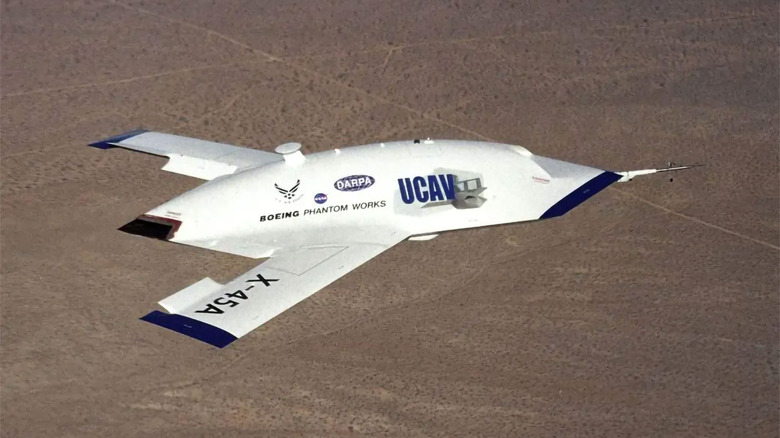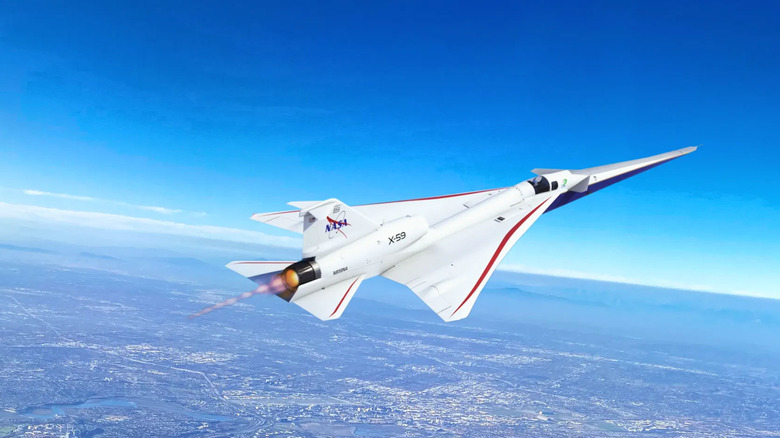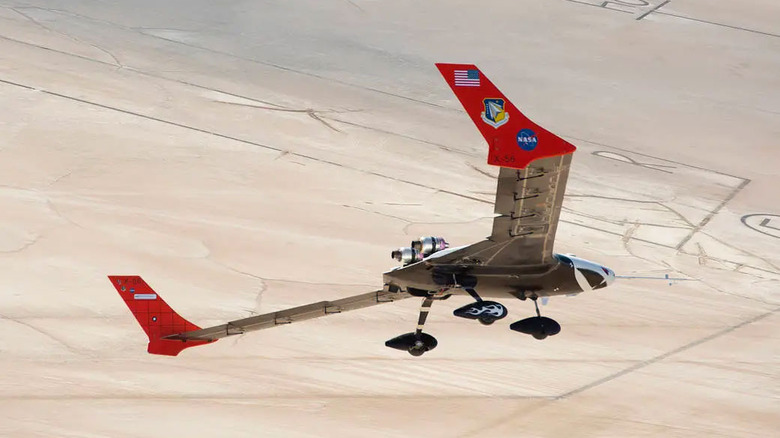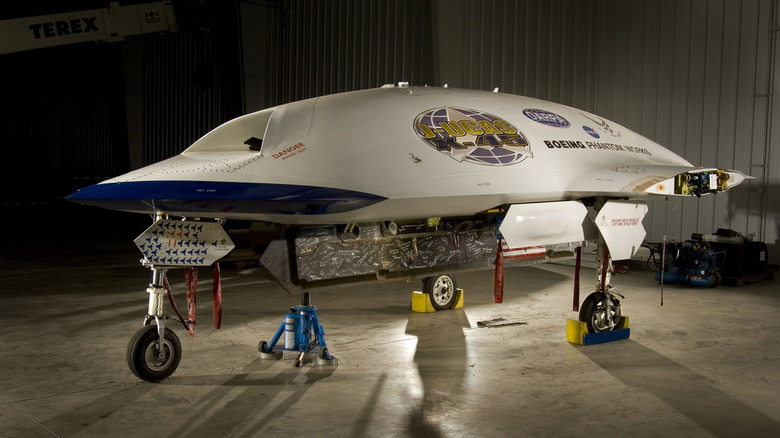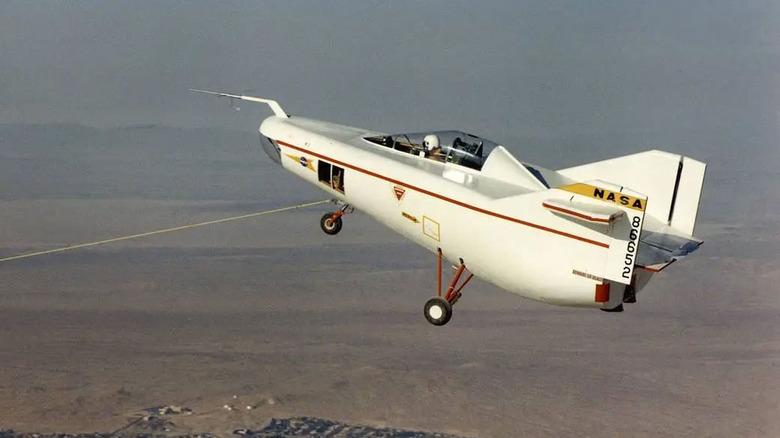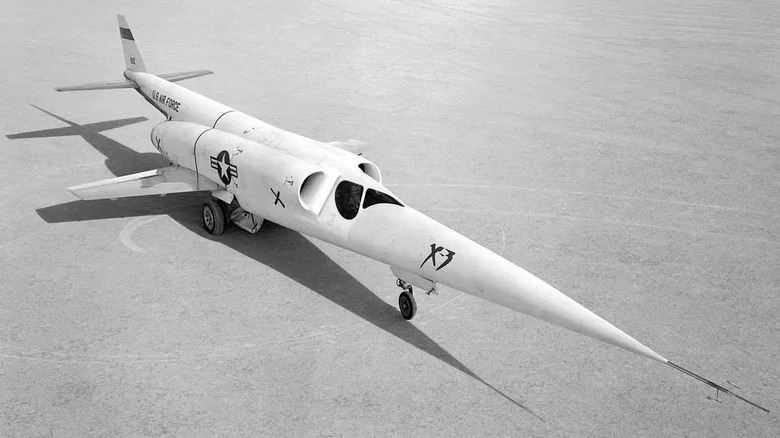6 Of The Strangest NASA X-Planes Ever Developed
The Armstrong Flight Research Center in Edwards, California, is home to NASA's experimental plane program, known as X-Planes. These experimental aircraft defy common convention, as the research center serves as one of the main sources of new aeronautic discovery and new technology in the world.
Originally founded in 1946, the program was established when the National Advisory Committee for Aeronautics met to uncover the effects of traveling faster than the speed of sound — a goal they would accomplish when Army Air Force Cpt. Charles "Chuck" Yeager broke the sound barrier and exceeded Mach 1 just a year later.
Since then, the Armstrong Flight Research Center has been the center of new scientific discoveries, as well as the catalyst for some very strange and unique aircraft designs. As odd as some of these designs may seem, many of the X-Planes developed by NASA would go on to solve important questions in science and inspire modern commercial and military aircraft.
X-59 QueSST
If you've always wondered why commercial airplanes weren't designed to go faster, part of the reason may surprise you. The United States government actually banned supersonic commercial flights in 1973 due to souring public reception of planes that could break the sound barrier.
In the summer of 1968, a demonstration showing the power of an F-105 resulted in a sonic boom that blew out 200 windows on the side of the Air Force Chapel at the Air Force Academy in Colorado. This caused a public uproar over the potential of commercial airliners to adopt the technology, and since then, planes have been limited to lower speeds.
The Lockheed Martin X-59 QueSST is the latest technology researching supersonic flight for commercial purposes. NASA engineers and scientists are developing ways to reduce the volume of a sonic boom to a softer thump rather than a loud clap. Scientists believe they can reduce this sound with the X-59's unique design.
Though the plane looks like something from a science fiction novel, it's just the latest experimental craft as part of NASA's X-Plane program. The first flight for the X-59 QueSST is scheduled to occur in 2024, with the program ending sometime in 2027.
XV-15 Tiltrotor
If you think that the XV-15 Tiltrotor aircraft looks like a helicopter and jet accidentally had a baby, you wouldn't be entirely wrong with your assumption. Development of the Bell Textron XV-15 started in 1973, with the aircraft's first flight occurring in October of 1980.
The Tiltrotor was NASA's attempt to develop a plane with vertical/short takeoff and landing capabilities (V/STOL). Essentially, what they wanted to design was an aircraft that could fly faster than a helicopter but could also take off vertically to accommodate shorter runways and aircraft carriers.
They accomplished their goal with the invention of the Tiltrotor, which was capable of taking off like a regular helicopter and then transforming mid-flight so that the rotor propellers were pointed like a traditional airplane for forward propulsion.
Though it doesn't seem like the idea would actually work, research, development, and testing for the XV-15 Tiltrotor would go on to inspire the SV-22 Osprey used by the United States Marine Corps (USMC). This aircraft is a collaboration between Bell and Boeing and transforms mid-flight, just like the Tiltrotor did over 40 years ago.
X-56A Multi-Utility Technology Testbed
Other than being a mouthful to say aloud, the X-56A Multi-Utility Technology Testbed (MUTT), developed by Lockheed Martin Skunk Works, was an important experiment examining aerodynamics and airplane physics. Long, thin wings are susceptible to uncontrollable vibrations known as flutter, which leads to aircraft instability. This limits potential designs and is an important area of study for aircraft manufacturers.
Research for the X-56A started in 2005 for the Air Force Research Laboratory, with the first test flights occurring in 2013. MUTT was a remotely controlled aircraft that measured 7.5 feet long with a 28-foot wingspan and weighed only 480 pounds. The long wings and relatively small body of the craft made it look more like a glider than an actual aircraft.
Development of the X-56A would eventually lead to a design methodology known as the Body Freedom Flutter research program, which proved that wing flutter could be predicted and prevented using a method called active control.
X-45 Unmanned Combat Air Vehicle
The X-45A Unmanned Combat Air Vehicle (UCAV), also known as Blue, could have potentially been mistaken for a flying saucer, as the unique design looks more like a floating pod than an actual aircraft.
Part of a joint DARPA, Air Force, and Navy program called the Joint Unmanned Combat Air System, Boeing's X-45 was one of the first examples of a completely crewless aircraft capable of autonomously suppressing enemy air defenses and serving in a strike role — a somewhat frightening prospect and not too dissimilar to today's modern military drones.
The aircraft would take its first flight in 2002, and three years later, on February 4, 2005, two X-45As controlled by one operator autonomously determined the optimal position, weapons, and fuel load to attack simulated ground targets properly. The aircraft then carried out a successful defensive strike against a random disguised target, proving that NASA's X-Plane was capable of working autonomously to engage threats.
Today, the General Atomics MQ-9A Reaper remotely piloted aircraft is used by the United States military.
M2-F1 Lifting Body
If you thought that an aircraft required wings, you'd be wrong, as the fleet of lifting-body aircraft developed by NASA would indicate. Designed as a way for astronauts to safely re-enter Earth from space, the M2-F1 resembles a motorboat or bathtub more than it does a highly sophisticated aircraft.
From 1963 to 1975, NASA's Armstrong Flight Research Center would test a variety of different Lifting Body variations, with the M2-F1 being one of the tackiest designs of them all.
The M2-F1 pioneered the lifting body program for NASA, with the construction of the craft completed in 1963. The first M2-F1, built by sailplane designer Gus Briegleb, was astoundingly created using a plywood shell placed over a steel frame. This design would lead the program to create several iterations over its duration, with the last model, the similarly peculiar-looking X-24B, taking its last flight in 1975.
X-3 Stiletto
NASA X-Planes probably wouldn't exist at all if it weren't for the Douglas X-3 Stiletto, a craft that began construction all the way back in 1949, making its first flight in 1952. The X-3 Stiletto was, at the time, a complete engineering marvel, albeit one of the strangest airplanes to ever exist.
Initially, the X-3 Stiletto was developed to take off from the ground under its own power, climb to high altitude, and then maintain a cruise speed of Mach 2. With a long, thin body, pointed tip, and tiny wings relative to the craft's overall size, the X-3 Stiletto would never live up to its lofty expectations. However, it would be the catalyst of a new discovery in aerodynamics.
On October 27, 1954, NACA pilot Joseph A. Walker made a historic flight, which almost caused a near-loss of the X-3 aircraft and potentially his own life. During the flight, Walker made a roll at high speeds, which caused the craft to gyrate before he was able to get it under control, exerting forces on the X-3 that exceeded 7 Gs. Eventually, Walker regained control of the Stiletto, but it was later discovered that the aircraft would have broken up mid-flight if the G forces had been higher.
This phenomenon of gyration, caused by the design of the craft, would later be called roll coupling or inertia coupling. The X-3 would take its final flight in 1956 and would subsequently be retired to the Air Force Museum.
